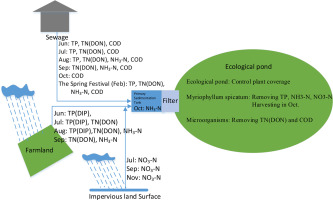当前位置:
X-MOL 学术
›
Ecol. Eng.
›
论文详情
Our official English website, www.x-mol.net, welcomes your
feedback! (Note: you will need to create a separate account there.)
Temporal variation pollution source and decontamination characteristics of the Myriophyllum spicatum treatment pond
Ecological Engineering ( IF 3.9 ) Pub Date : 2020-01-01 , DOI: 10.1016/j.ecoleng.2019.105675 Jinfeng Xue , Haicai Li , Jiazhi Du , Mingyue Zhou , Yang Mei
Ecological Engineering ( IF 3.9 ) Pub Date : 2020-01-01 , DOI: 10.1016/j.ecoleng.2019.105675 Jinfeng Xue , Haicai Li , Jiazhi Du , Mingyue Zhou , Yang Mei

|
Abstract The analyses for temporal variation pollution sources of Qijiawan treatment pond show that in non-livestock and poultry breeding area, total phosphorus (TP) pollution mainly happens during the period from June to August with both farmland and domestic sewage as the main pollution source and during the Spring Festival with domestic sewage as the source. Total nitrogen (TN) pollution mainly occurs during the rainy season from July to September taking domestic sewage and nitrogen fertilizer as main sources, besides the Spring Festival with domestic sewage as the main pollution source. As for ammonia nitrogen pollution, it is similar to TN pollution, and domestic sewage is the first pollution source. The emphasis of pollution control should be put on the phosphorus especially particle phosphorus (PP) in the domestic sewage and dissolved organic nitrogen (DON) in the sewage and farmland fertilizer. In addition, nitrate‑nitrogen (NO3−-N) is mainly from the impervious land surface and transfers into the treatment pond with rainfall. COD into the pond in the rainy season was greater than that in the dry season, but anyhow, it firstly comes from domestic sewage, especially in the Spring Festival. Research on the purification performance of Myriophyllum spicatum treatment pond shows that it is relatively difficult for Myriophyllum spicatum to absorb COD and TN with DON as the main form, but it is very easy to absorb TP and NH3-N before October. Therefore, Myriophyllum spicatum should be harvested in this month in order to realize effective removal. The removal of COD and TN mainly depends on microbial degradation, and so it should be enhanced in order to improve water quality of treatment pond.
中文翻译:

狐尾藻处理池污染源及净化特征的时间变化
摘要 齐家湾处理池污染源时空变化分析表明,在非畜禽养殖区,总磷(TP)污染主要发生在6-8月,以农田和生活污水为主要污染源,春节期间以生活污水为源头。总氮(TN)污染主要发生在7-9月的雨季,以生活污水和氮肥为主要来源,除春节外,以生活污水为主要污染源。至于氨氮污染,与TN污染类似,生活污水是第一污染源。污染控制的重点应放在生活污水中的磷特别是颗粒磷(PP)和污水和农田肥料中的溶解有机氮(DON)上。此外,硝酸盐-氮(NO3--N)主要来自不透水地表,并随降雨转移到处理池中。雨季进入池塘的COD大于旱季,但无论如何,它首先来自生活污水,尤其是在春节。对狐尾藻处理池净化性能的研究表明,狐尾藻以DON为主要形式吸收COD和TN相对较难,但在10月之前吸收TP和NH3-N非常容易。因此,应在本月采收狐尾兰,以实现有效清除。
更新日期:2020-01-01
中文翻译:

狐尾藻处理池污染源及净化特征的时间变化
摘要 齐家湾处理池污染源时空变化分析表明,在非畜禽养殖区,总磷(TP)污染主要发生在6-8月,以农田和生活污水为主要污染源,春节期间以生活污水为源头。总氮(TN)污染主要发生在7-9月的雨季,以生活污水和氮肥为主要来源,除春节外,以生活污水为主要污染源。至于氨氮污染,与TN污染类似,生活污水是第一污染源。污染控制的重点应放在生活污水中的磷特别是颗粒磷(PP)和污水和农田肥料中的溶解有机氮(DON)上。此外,硝酸盐-氮(NO3--N)主要来自不透水地表,并随降雨转移到处理池中。雨季进入池塘的COD大于旱季,但无论如何,它首先来自生活污水,尤其是在春节。对狐尾藻处理池净化性能的研究表明,狐尾藻以DON为主要形式吸收COD和TN相对较难,但在10月之前吸收TP和NH3-N非常容易。因此,应在本月采收狐尾兰,以实现有效清除。










































 京公网安备 11010802027423号
京公网安备 11010802027423号